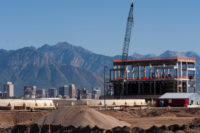A $348.6-million federal loan provided for Salt Lake City's new water-reclamation plant will cut ratepayer costs to build the $711-million project that is intended to reduce pollution entering Great Salt Lake and replace a 55-year-old facility.
The loan is funded through the federal Water Infrastructure Finance and Innovation Act and administered by the U.S. Environmental Protection Agency.
“This WIFIA loan will help us save up to $100 million in ratepayer fees and allows us to do this project without having to look to other funding mechanisms,” says Jesse Stewart, deputy director of Salt Lake City Public Utilities..
The current water reclamation facility processes 33 million gallons of wastewater from about 200,000 customers in the 110-sq-mile Salt Lake City service area. The new plant is among the largest public works projects ever undertaken by the city.
When complete, it will treat the same amount of water as the current plant, but it is designed to accommodate future expansion and meet anticipated new regulations.
The plant will use a biological nutrient removal process to significantly reduce levels of phosphorus and other nutrients discharged into the Great Salt Lake. Phosphorus can be detrimental even to the highly saline lake and the wetlands that border it. Regulations taking effect in 2025 will permit only one milligram of phosphorus per liter of water discharged.
Stewart says the new plant will have seismic and electrical upgrades and systems to meet new water-quality requirements, adding that "it is something that would have had to happen eventually, and this loan just gives us the best financing mechanism." He says the facility will increase system resilience to seismic events and floods.
The new treatment facility is being built on approximately 20 of 135 acres occupied by the current facility. The project site was previously filled by concrete slabs used for drying biosolids recovered from wastewater.
Jason Brown, chief engineer for Salt Lake City Public Utilities, says much of the work thus far has been site preparation.
“There are about 53,000 wick drains going in here, with around 1,000 miles of drain material going in the ground,” he says. “We’ll most likely be taking that water and processing it through our plant.”
The Salt Lake City project is one of 38 that EPA invited to apply for the loan about a year ago. It is the 28th agency- awarded loan and the first to a project in Utah. Lee Forsgren, EPA deputy assistant administrator for water, says the agency has provided $6.1 billion in credit assistance to help finance water infrastructure projects since 2017



Post a comment to this article
Report Abusive Comment